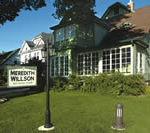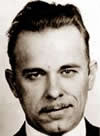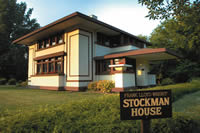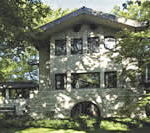The history of this beautiful region dates back long before the area was settled by farmers and trappers. The early inhabitants of Cerro Gordo County were the Winnebago and Sioux tribes. Living off of the lush forests and bountiful lake, the tribes enjoyed the land for many years before Joseph Hewitt and James Dickirson arrived in the area in 1851.
Hewitt and Dickirson's settlement soon became an oasis in the Midwest; Hewitt traded with the Indians and Dickirson farmed the rich soil. In 1853, the town of Shibboleth was settled by John Long, Hewitt and George Brentner where the waters of the Winnebago River and Willow Creek come together. The town changed names several times, from Shibboleth, to Masonic Grove, to Masonville and finally to Mason City, as it is know today.
The area is home to large deposits of limestone and clay, which opened the doors to a thriving mining and cement industry. By 1911, two large cement companies were operating in Mason City, and the cement industry continues to be an important part of the community today. Brick and tiles were also made in Mason City; the area was one of the largest producers of brick and tile in 1912. The brick and tile industry has since disappeared from the area, but Mason City has supplemented its early industries through its development as a service, retail and distribution center.
“The Day the Music Died”:
 The Mason City Airport dedication was attended by Charles Lindbergh shortly after his historic transatlantic flight. Sadly, more than 30 years later, the airport became remembered for a much different tragic event.
The Mason City Airport dedication was attended by Charles Lindbergh shortly after his historic transatlantic flight. Sadly, more than 30 years later, the airport became remembered for a much different tragic event.
On February 3, 1959, singer and musician Buddy Holly gave a performance at the Surf Ballroom's Winter Dance Party in Clear Lake. Holly, Ritchie Valens and J.P. "The Big Bopper" Holly Monument Richardson boarded a private plane at the Mason City Airport to travel to their next engagement. The flight was barely off the ground when icy weather caused the plane to crash in a field near Clear Lake. A memorial to the three rock 'n' roll legends stands in the field today, commemorating "The Day the Music Died."
Meredith Wilson “The Music Man”:
 The music still plays in Mason City, and you may hear some familiar tunes while strolling down Pennsylvania Avenue. The boyhood home of Meredith Willson can be found in Mason City. Willson is best known as the composer of the Broadway musicals "The Music Man" and "The Unsinkable Molly Brown"; he also wrote the familiar Christmas tune, "It's Beginning to Look a Lot Like Christmas."
The music still plays in Mason City, and you may hear some familiar tunes while strolling down Pennsylvania Avenue. The boyhood home of Meredith Willson can be found in Mason City. Willson is best known as the composer of the Broadway musicals "The Music Man" and "The Unsinkable Molly Brown"; he also wrote the familiar Christmas tune, "It's Beginning to Look a Lot Like Christmas."
Mason City was the inspiration for River City in "The Music Man," which debuted on Broadway on December 19, 1957, and ran for 1,376 performances. The popular musical later came alive on the big screen in a Hollywood adaptation starring Shirley Jones and Robert Preston. The musical was nominated for nine Tony Awards and won six, including Best Musical. The play has been revived both on Broadway and in the movies - a Walt Disney production of "The Music Man" stars Matthew Broderick and Kristin Chen. The Beatles even capitalized on the success of the musical with their cover of "Till There Was You."
 While in Mason City visit the birthplace and boyhood home of this song writer and playwright of "The Music Man," which is a restored 1895 modified Queen Ann house.
While in Mason City visit the birthplace and boyhood home of this song writer and playwright of "The Music Man," which is a restored 1895 modified Queen Ann house.
1934 Dillinger Robbery:
 On March 13, 1934, the notorious bank robber John Dillinger and his accomplices, Baby Face Nelson, John Hamilton and Tommy Carroll , attempted to rob the First National Bank owned by YMCA chair, Charles McNider, in Mason City. Dillinger and Hamilton both sustained gunshot wounds during the robbery attempt. Expecting to net some $240,000 from the robbery, they were disappointed to get only $52,000. Dillinger, who had become somewhat of a Robin Hood figured to the public, had planned to use his share of the $240,000 to flee the country. A local legend is that two of Dillinger's gang stayed at the Mason City YMCA two weeks earlier in order to "case the job".
On March 13, 1934, the notorious bank robber John Dillinger and his accomplices, Baby Face Nelson, John Hamilton and Tommy Carroll , attempted to rob the First National Bank owned by YMCA chair, Charles McNider, in Mason City. Dillinger and Hamilton both sustained gunshot wounds during the robbery attempt. Expecting to net some $240,000 from the robbery, they were disappointed to get only $52,000. Dillinger, who had become somewhat of a Robin Hood figured to the public, had planned to use his share of the $240,000 to flee the country. A local legend is that two of Dillinger's gang stayed at the Mason City YMCA two weeks earlier in order to "case the job".
Frank Lloyd Wright:
 Cultural icons are plentiful in Mason City's history. The famous architect and designer Frank Lloyd Wright (1867 - 1959) was not a native North Iowan, but he left his mark during a stay in Mason City in the early 1900's. Wright was commissioned to design a new hotel and bank building for the city by businessmen James Markley and James Blythe. Markley's neighbor, Dr. G.C. Stockman, persuaded Wright to design a residential home for his family. The home was finished in 1908 and was the first and only Prairie School-style house designed by Wright in Iowa. Wright left Iowa in 1910, just as construction of the Park Inn Hotel and City National Bank was about to begin. The Park Inn is Wright's only remaining hotel; it became the prototype for the world-famous Imperial Hotel in Tokyo. The City National Bank is widely considered the better of two banks Wright designed.
Cultural icons are plentiful in Mason City's history. The famous architect and designer Frank Lloyd Wright (1867 - 1959) was not a native North Iowan, but he left his mark during a stay in Mason City in the early 1900's. Wright was commissioned to design a new hotel and bank building for the city by businessmen James Markley and James Blythe. Markley's neighbor, Dr. G.C. Stockman, persuaded Wright to design a residential home for his family. The home was finished in 1908 and was the first and only Prairie School-style house designed by Wright in Iowa. Wright left Iowa in 1910, just as construction of the Park Inn Hotel and City National Bank was about to begin. The Park Inn is Wright's only remaining hotel; it became the prototype for the world-famous Imperial Hotel in Tokyo. The City National Bank is widely considered the better of two banks Wright designed.
 In 1912, Wright's students designed homes in the Rock Crest/Rock Glen development, which is currently listed Prairie House on the National Register of Historic Places. It is the largest collection of Prairie School architecture unified by one setting.
In 1912, Wright's students designed homes in the Rock Crest/Rock Glen development, which is currently listed Prairie House on the National Register of Historic Places. It is the largest collection of Prairie School architecture unified by one setting.
Find out more about Wright on the Park and the Park Inn project!
MacNider Art Museum:
 Another historic building in Mason City is home to The Charles H. MacNider Art Museum. Gen. Charles Hanford "Jack" MacNider (1889 - 1968) was born in Mason City and became a successful businessman and industrialist. In the 1960's the MacNider family purchased and donated a historic home to serve as a museum. Today the museum is home to one of the nation's best collections of American art, as well as the treasured "World of Puppets" collection. The puppets in the collection are the work of renowned puppeteer and Mason City High School graduate Bil Baird (1904 - 1987) and include the marionettes used in the "Sound of Music."
Another historic building in Mason City is home to The Charles H. MacNider Art Museum. Gen. Charles Hanford "Jack" MacNider (1889 - 1968) was born in Mason City and became a successful businessman and industrialist. In the 1960's the MacNider family purchased and donated a historic home to serve as a museum. Today the museum is home to one of the nation's best collections of American art, as well as the treasured "World of Puppets" collection. The puppets in the collection are the work of renowned puppeteer and Mason City High School graduate Bil Baird (1904 - 1987) and include the marionettes used in the "Sound of Music."

 Find A Business / Search Site
Find A Business / Search Site